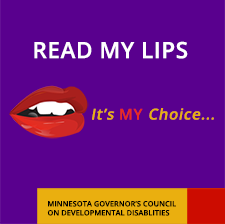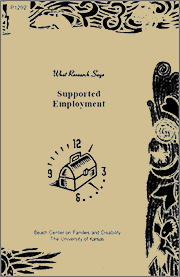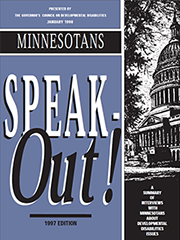The Minnesota Governor's Council on Developmental Disabilities
FORTY-FIVE YEARS OF HISTORY 1971-2016
This article, mainly covering 1992 – 1996, is the fifth of nine segments that will move the history along in five-year sections to bring the Council's work to the present. For context refer to this site's sections "Parallels in Time: A History of Developmental Disabilities" and "With an Eye to the Past" for laws, publications and other documents mentioned in text. In addition two documents were used extensively: 2001 Annual Report, and "Partners in Policymaking. Changing Lives. Changing Policies".
PARTNERS IN POLICYMAKING®:
Partners remained a consistently important focus for the Council and, during the first decade of the program, it demonstrated its success. Training session evaluations, six month followup surveys and longitudinal studies showed that the basic design principles, and the core values and competencies based on best practices that are the foundation of the Partners program were an effective means to encourage continuing public policy advocacy by individuals with developmental disabilities and their families.
In 1990, the Council worked with Ed Roberts at the World Institute on Disability to secure additional federal funding to teach other states how to replicate the program. A Project of National Significance grant provided the financial support to hold the first National Academy in California. Twelve states were invited to attend; a year later, five of those states were operating a program.
In 1992 the Council worked with the Developmental Disabilities Council in Texas to cosponsor the second National Academy that was attended by representatives from twenty-four states, 12 of the original states and 12 new states. The 1993 National Academy presented the program to thirty-six states.
The network of Partners graduates, more than 4000 by 1995, were advocating for persons with developmental disabilities across the nation.
In 1992, the first National Summer Leadership Institute was held in Minnesota for Partners graduates, offering training on current issues, additional leadership skills, and networking opportunities. National Institutes were also held in 1993, 1994, 1997, and 1998.
Additional workshops are offered to Minnesota Partners graduates on an annual basis "to stay ahead of the curve and become trusted resources for educating policymakers and are a time to network and share experiences with others."
The development of local leadership among culturally diverse parents of children with developmental disabilities is extremely important to creating inclusive, multicultural communities. A Council survey found that "few parents in those communities knew that their children with disabilities had specific rights to education and other services and supports." The Cultural Outreach Program was created to provide immediate information on services available and how to access them; and education and training to build beginning leadership and advocacy skills, and help parents communicate with educators and support providers.
In 1992, to encourage participation of parents of children with developmental disabilities in racial and ethnic minority communities in the Partners program, the Council began to fund an outreach and leadership training program in the African American community. In subsequent years, Council funds were allocated to outreach programs in the Native American community from 1995 through 2003; in the Hispanic community from 2000 to 2013; and in the Asian community from 2004 to 2006.
The cultural outreach programs are intended as the first step to the Partners program for adults with disabilities and parents with children with developmental disabilities who are also members of minority communities. These programs offer outreach services and personal support in addition to leadership training, and introduce the concepts of the Partners program.
SUPPORTED EMPLOYMENT:
With more and more individuals leaving institutions, and completing their high school education, the need for employment services and training increased in the 1990s. To achieve independent living, make life choices, and pursue the full inclusion and integration in society that is the right of all people, the opportunity for real work is important.
Supported Employment is defined as,
…paid employment for persons for developmental disabilities for whom competitive employment is unlikely because of their disabilities in a setting in which persons without disabilities are employed. "It is real work for real pay." [https://mn.gov/mnddc/parallels2/pdf/90s/93/93-SET-BCD.pdf]
Beginning in the 1990s, the Council recognized that employment for individuals with developmental disabilities was a growing concern and careers, not just entry level jobs, were being discussed. That included training to help individuals with developmental disabilities move up the career ladder:
With supported employment what happened was you went to an employer and said do you have a job and it did not matter what you said, as a person with a disability, you got placed where there was an open job. This was in the mid-80s because we were just starting out on supported employment.
What happened over time was people changed from that approach to one of interviewing people and they called it "discovery", getting to know you and your interests and what you care about, and then trying maybe job sharing or job experimentation where you try out jobs and then you negotiate a position.
Employment support services were initially given by agencies that helped with "discovery" and placement. Job coaches trained an individual in the specific job duties as well as how the workplace functions. The job coach's job was to create an environment where the employer was happy with the worker's progress in the job and where the employee achieved a level of independence and learned to get any support needed from other workers at their job site.
LEGISLATION
- 1990 INDIVIDUALS WITH DISABILITIES EDUCATION ACT [IDEA]:
In 1990, the Education for All Handicapped Children Act was revised and renamed IDEA. Changes involved the scope of early intervention and special education services for children with disabilities. Language was added to support the transition from school to adulthood with an expanded IEP team that included the parents of the child, at least one regular education and special education teacher, a representative of the public agency, an individual who could "interpret the instructional implications of evaluation results," and "if appropriate, the child" (Section 300.344 IEP team). - 1994 DD ACT REAUTHORIZATION:
The 1994 reauthorization of the Developmental Disabilities Act reemphasized basic concepts; goals included choice, living in and contributing to community, pursuing productive lives, having relationships, and inclusion for persons with developmental disabilities. The importance of informed decision-making regarding services and supports was reaffirmed with those decisions made by the individual and the family.
PUBLICATIONS
Shifting Patterns [1992] presented the key concepts of self determination and empowerment – freedom of choice, control over various aspects of one's life, full community participation, dignity, responsibility, and opportunity. A shift in the beliefs and attitudes about individuals, services, professionals, and community are woven through projects and programs that the Council funded during the 1990s, including the Partners program.
Making Your Case [1994] offers techniques and insights for effective communication skills in the legislative process and how to positively influence public policy at all levels of government

Read My Lips [1987-1993] was a resource guide with a series of activities and checklists for individual planning meetings, education and transition planning, supported employment and work needs, and housing; and self advocacy objectives.
Minnesotans Speak Out [1992, 1997] A Department of Human Services study group held town meetings to listen to what Minnesotans thought about the strengths and issues of how services were provided to individuals with developmental disabilities. Six themes were identified:
- We have a lot to be proud of and much remains to be done!
- Individualization
- Staffing
- Leadership and Bureaucracy
- Inequity of Resources - Inconsistency in the System
- Community Programs and Support
In 1997, a Speak Out process resulted in similar themes that participants identified as still relevant but shifts were too few and too slow in coming. The six themes were:
- The lack of services in rural Minnesota.
- The need to focus on the individual rather than a program.
- The need to increase the salaries of the people who deal directly with the individual.
- The system seems to be top heavy with not enough of the resources getting to the individuals who need the help.
- Most of the participants thought that the family should be taken more into consideration when decisions are made concerning the person with the disability. [https://mn.gov/mnddc/extra/publications/Speak_Out.pdf]
RECAP:
In 1976, the Council name changed to the Minnesota Governor's Planning Council on Developmental Disabilities. In 1995, a Congressional change made it the Minnesota Governor's Council on Developmental Disabilities.
When Governor Arne Carlson took office in 1991, there were 1,100 people still living in Minnesota's state institutions. In 1992, his Chief of Staff met with representatives from the Departments of Human Services, Administration, Health, Housing, Employee Relations, and Finance; and the Ombudsman Office to study privatization. They began developing a plan to remove the state from the institutional care system.
In July 2000 the last individual with developmental disabilities left the Minnesota state institution system. On February 7, 2001, "With an Eye to the Past," prepared by the Council, debuted at a recognition luncheon, celebrating the contributions of 100 Minnesotans to improve the care and quality of life of thousands of Minnesotans with developmental disabilities.
The Council continued to support the Partners in Policymaking leadership training program, measuring the immediate and long term benefits, and tracking participant and graduate results in terms of the outcomes identified in the DD Act – independence, productivity, self-determination, and integration and inclusion.








